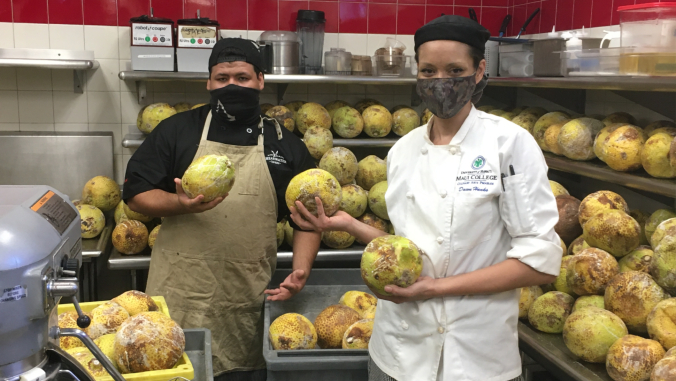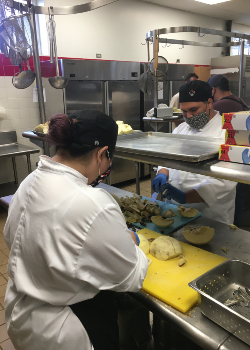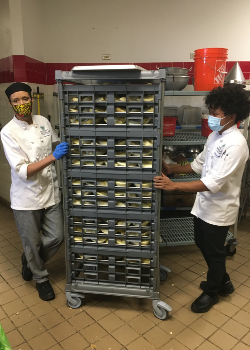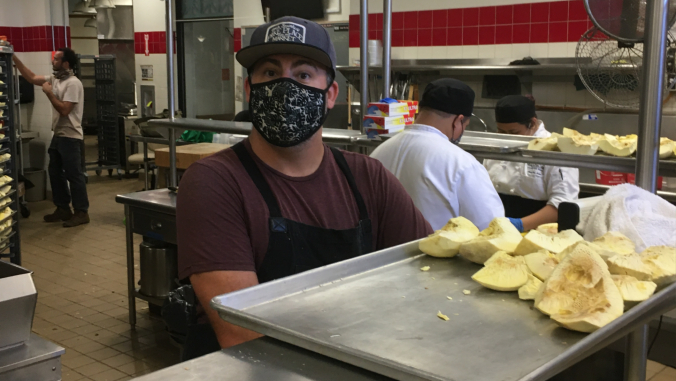
This editorial by University of Hawaiʻi Maui College Chancellor Lui K. Hokoana ran in The Maui News on November 28, 2020.
One of the “canoe crops” brought by Polynesians to Hawaiʻi, possibly as early as the third century, ʻulu (breadfruit) is a food decidedly suited to our times. The mature fruit is a nutritious and adaptable substitute for a potato. It can be boiled, steamed, baked, fried, even made into crunchy ʻulu chips. Maybe some of you opted for mashed ʻulu rather than the traditional mashed potatoes on your Thanksgiving table. Young fruit can be pickled. Ripe—even overripe—fruit is sweet and creamy and delicious in desserts. The wood from ʻulu trees is light in weight and was multi-purpose in ancient Hawaiʻi. The National Tropical Botanical Garden’s Breadfruit Institute at Kahanu Gardens in Hāna grows almost 100 varieties.
Those ʻulu trees in Hāna is where this story begins. It may appear to be a long—LONG—way from raising bison on the Great Plains of the U.S. Mainland to cultivating ʻulu in Hāna, but agriculture is agriculture, according to Hāna Ranch Manager Duane Lammers who actually traveled that road. “John Cadman (a chef and one of Maui’s most ardent ʻulu advocates) brought us our first trees from Kahanu Gardens and he introduced us to the ʻUlu Co-Operative on Hawaiʻi Island,” explains Lammers.

“This is the third year of production, and of our 100 trees, 87 are producing full tilt,” says Lammers. The fruit has to be shipped to the co-op on Hawaiʻi Island for processing which is unwieldy, at best. “With all the disruption Young Brothers was starting to experience when the pandemic hit us, I knew it was going to get worse.” When he expressed that concern to Chef Gary Johnson, who has worked at several Maui restaurants and has done a lot of work with the Ranch, Johnson introduced him to Chris Speere, who heads up our Maui Food Innovation Center.
“I’d been through the Maui Food Innovation program myself,” says Johnson who is now the garden coordinator for Grow Some Good, a program in multiple Maui schools. “Fortunately, I knew a lot of the players who would need to be involved. Along with Chris, we were able to fast track the partnership, including with the Department of Health.”
So one Saturday morning in early October, a truck pulled up to the loading dock at the Food Innovation Center and delivered about 2,000 pounds (yes, a ton) of ʻulu. Several of our culinary arts students were waiting. Over the course of the weekend—under the supervision of Speere and Johnson—they washed it, weighed it and cooked it in 350-pound batches to an internal temperature of 135 degrees, cut the ʻulu in half, put them on sheet trays on rolling racks, rolled them into the walk-in refrigerator, cooled them, quartered them, seeded them, weighed them again and froze them. The following week, they were packed in 10-pound bags, then 40-pound cases, labeled and put back into the freezer. Ready to distribute. Ready to prepare, serve and eat. That process has taken place every weekend since then and will continue through December.
Jacob Devlin is in his final semester of our Culinary Arts program. “A friend of mine was working with Nicolette van der Lee (director of the Sustainable Living Institute of Maui) who was looking for someone to work with Native Hawaiian vegetables and plants. I was introduced to Chris Speere and started working on the ʻulu project,” he says. “I had never heard of ʻulu before. Now, I’ve experimented with it in stir-fries and even in desserts. And I’ve made ʻulu scones!”

First year culinary arts student Phrincess Constantino wasn’t really familiar with ʻulu, either. “In high school, I had worked with Chris Speere on an internship at the Innovation Center. So, when one of my professors asked if anyone was interested in the ʻulu project, I thought it would be a good way to get some experience in a commercial kitchen. It’s been a good and interesting experience.”
The upshot? “With little lead time, the college provided us great information, leadership and enthusiastic students,” says Lammers. “It all serves as proof of concept for us and we’re now looking at the possibility of building a processing plant for ʻulu and for other products, as well, right here in Hāna.”
As for Chef Johnson? “My purpose in this is to create a strong channel of locally grown canoe crops to be able to proliferate on the Island for our food security and sustainability. And I want ʻulu to replace the potato in our diets.”
Oh, and those tons of ʻulu? They’re being sold commercially by VIP Foodservice.
Sometimes it takes a village—and sometimes it takes an island.
More information about the Maui Food Innovation Center and the UH Maui College Culinary Arts program can be found online.
*Lui K. Hokoana is chancellor of UH Maui College. Kaʻana Manaʻo, which means “sharing thoughts,” appears on the fourth Saturday of each month. It is prepared with assistance from UH Maui College staff and is intended to provide the community of Maui County information about opportunities available through the college at its Kahului campus and its education centers.


